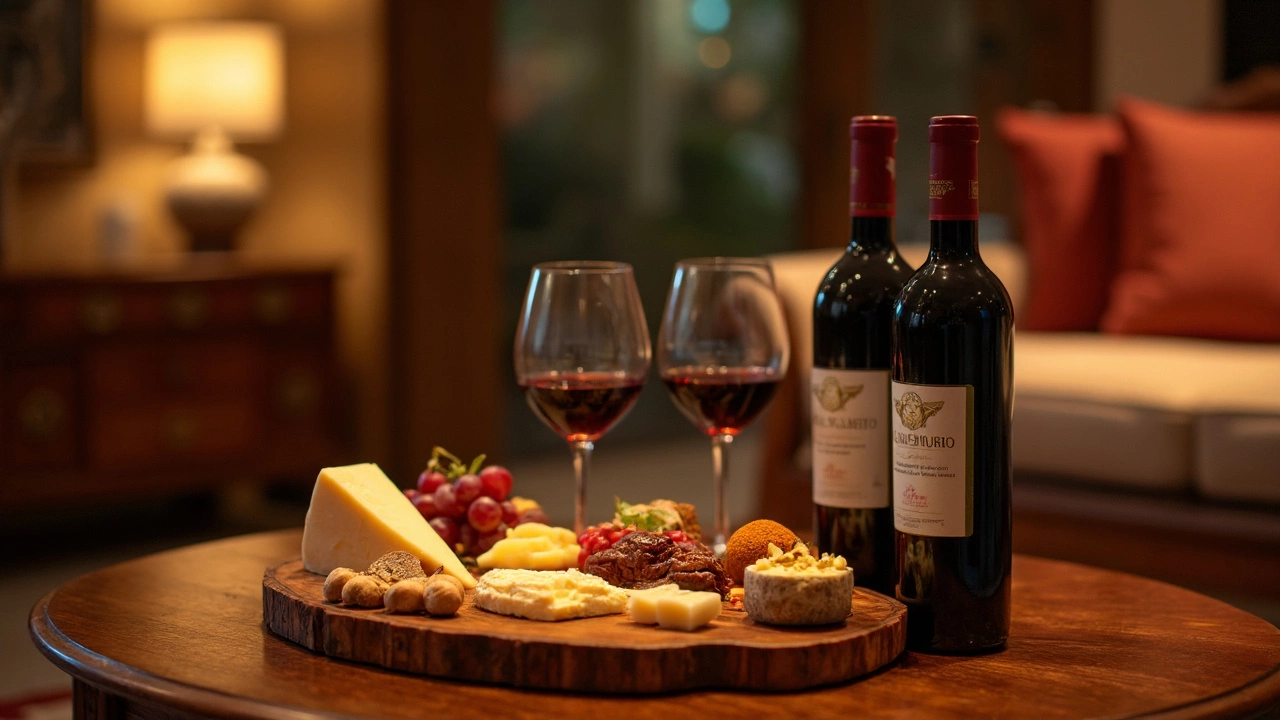
Wine and cheese—these two seem to go together like, well, wine and cheese! But once you dive into specifics like merlot or cabernet sauvignon, things can get a little tricky. So, how do you find the perfect cheese to match your bottle? It's simpler than it seems.
Let's get down to basics. Merlot is a versatile red wine known for its soft, fruity flavors, making it a crowd-pleaser. Cabernet Sauvignon, on the other hand, is bold and robust with dark fruit notes. Their different profiles mean they pair best with different cheeses. Starting with the wrong cheese could dull both the wine and cheese flavors, but the right match can elevate your entire tasting experience.
For merlot, think about cheeses that complement its gentle fruitiness. Soft cheeses like Brie or Camembert play well with merlot's friendly nature. On the flip side, if you're serving cabernet sauvignon, opt for cheeses that can handle its strong presence—aged cheddars or even gouda can do the trick.
- The Basics of Wine and Cheese Pairing
- Merlot Pairing Essentials
- Cabernet Sauvignon: A Heavenly Match
- From Soft to Hard: Cheese Recommendations
- Practical Tips for Serving
- Common Pairing Pitfalls to Avoid
The Basics of Wine and Cheese Pairing
The art of pairing wine and cheese might seem like a skill best left to the connoisseurs, but anyone can learn it with a bit of know-how. Understanding some basic principles can help you make great matches even if you're new to the game.
Cheese comes in all shapes, textures, and flavors, much like wine. And like merlot or cabernet sauvignon, each cheese has characteristics that interact with wine as they mingle. First and foremost, balance is key. You don’t want either the wine or the cheese to overpower the other.
Consider Flavor Intensity
Start by matching intensity. Mild cheeses pair best with light-bodied wines, while stronger cheeses need a wine that can stand up to their bold flavors. Think about it as a balancing act—the bolder the cheese, the bolder the wine should be.
Texture and Body
The texture of the cheese and the body of the wine also play a significant role. Creamy, soft cheeses typically pair beautifully with wines that have a good amount of acidity or tannin, which can cut through the richness. Meanwhile, hard, aged cheeses often complement rich, full-bodied wines.
- Soft cheeses: Pair with wines high in acidity.
- Hard cheeses: Pair with full-bodied wines.
Regional Pairings
Another handy tip is to go local. Regional pairings, where you match wines and cheeses from the same geographic area, often result in surprisingly good matches. It's like the two have grown up together and know each other's quirks.
Last but not least, remember personal preference matters. Whatever guidelines you follow, it's important that the pairing pleases your palate. So, don’t be afraid to experiment. Who knows? You might just stumble upon the next classic wine and cheese pairing.
| Cheese Type | Wine Suggestions |
|---|---|
| Soft | High-acid wines |
| Hard | Full-bodied wines |
Merlot Pairing Essentials
When you think of merlot, imagine a warm hug that wraps you up in flavors of plum, black cherry, and subtle hints of vanilla. It's smooth, approachable, and a real people pleaser. So, when pairing cheese with merlot, you want something that enhances these lovely characteristics without overpowering them.
Savor the Soft Cheeses
Merlot's gentle character pairs beautifully with soft, creamy cheeses. Think Brie, Camembert, or even a mild goat cheese. These varieties echo the wine's texture, creating a symphony of flavors and an unmatched creamy experience.
If you're looking for something slightly more assertive, try a bloomy rind cheese like triple cream cheese. The fat content in these cheeses cuts through the acidity of merlot, making every bite a decadent treat.
Go for the Blues
You might not expect it, but some blue cheeses can work surprisingly well with merlot! The trick is to choose something milder, like a Gorgonzola dolce. Its creaminess and understated blue veins are perfect for not overshadowing the wine's fruitiness.
Experiment with Aged Options
If you're in for some adventure, take a stab at experimenting with aged gouda or cheddar. Their nutty profiles complement the subtle oak notes often found in merlot. Just remember, balance is the key—you don't want the cheese to steal the show from your wine.
Delightful Duo Tips
- Always bring your cheese to room temperature before serving. It allows flavors to open up and pair better with wine.
- Consider adding nuts or dried fruits to your platter. They're not only good for texture but can enhance the tasting experience.
Remember, pairing isn't always about strict rules. Trust your taste buds, and if a cheese just works with your favorite merlot, that's all that matters!
Cabernet Sauvignon: A Heavenly Match
When it comes to cabernet sauvignon, think bold, think big. This wine brings deep flavors of blackcurrant, plum, and sometimes a hint of mint or tobacco. It's a wine that doesn't shy away from letting you know it's there, making it a fantastic partner for strong cheeses.
The Perfect Cheese Partners
Aged cheddar is a classic choice when sipping cabernet. Its rich, nutty flavor holds up against the wine's intensity, creating a beautiful harmony of tastes. Another great option is gouda, especially when it’s aged. The caramel notes of gouda play off the dark fruit flavors in the wine. Let’s not overlook blue cheese, either. Its sharp, salty nature contrasts cabernet’s fruitiness, crafting a balanced bite.
Why It Works
The reason these cheeses pair so well with cabernet boils down to the cheese's fat content. It mellows the wine's tannins, a component that gives cabernet its signature level of dryness. This interaction brings out the fruity notes in the wine more clearly, while also adding another layer of complexity to the cheese.
Pairing Tips
- Always serve your cabernet slightly below room temperature, around 60-65°F (15-18°C). It allows the flavors and aromas to shine.
- Let your cheese sit at room temperature for about an hour before serving. Cold cheese can mask flavors.
- Don't be afraid to experiment! Chardonnay might work well with different types, so have fun finding your perfect cheese combo.
As you explore these classic wine and cheese pairings, you'll find your taste buds embarking on a delightful journey. The right cheese really can make a great cabernet taste divine.

From Soft to Hard: Cheese Recommendations
So, you're standing in the cheese aisle, overwhelmed by options. Don't stress! Pairing the right cheese with your merlot or cabernet sauvignon can transform your experience.
Soft Cheeses for Merlot
When it comes to soft cheeses, the creamy and mellow flavors complement the gentle fruitiness of a merlot beautifully:
- Brie: Its earthy flavor and gooey texture work wonders with merlot's plush notes. Plus, almost everyone loves a good brie.
- Camembert: Similar to brie but a bit more intense, this cheese adds a touch of savory goodness to your glass of merlot.
- Fontina: A little milder, Fontina balances the wine's fruit-forward taste with its smooth, buttery texture.
Semi-Hard Cheeses for Cabernet Sauvignon
Semi-hard cheeses, with more substance, can handle the bold character of a cabernet sauvignon:
- Gouda: The nutty and caramel undertones provide a pleasing contrast to the complex flavors of cabernet.
- Cantal: A French treasure with a flavor that ranges from sweet to sharp, perfect for a cab's rich tannins.
Hard Cheeses
Finally, the hard cheeses. These packs a punch and complement strong wines like a champ:
- Aged Cheddar: Bring on the sharp! It cuts through the richness of a cabernet, making it a must-try pairing.
- Pecorino: Though not for everyone, its salty punch gets along famously with a well-versed cabernet or even a seasoned merlot drinker.
| Cheese | Wine Pairing |
|---|---|
| Brie | Merlot |
| Camembert | Merlot |
| Fontina | Merlot |
| Gouda | Cabernet Sauvignon |
| Cantal | Cabernet Sauvignon |
| Aged Cheddar | Cabernet Sauvignon |
| Pecorino | Cabernet Sauvignon |
Experiment with these cheese suggestions, and you'll soon have your own favorites for wine and cheese pairing. Remember, these are just guidelines—your palate knows best!
Practical Tips for Serving
Alright, you've got your bottle of merlot or cabernet sauvignon and the perfect cheese to match. Now, let's talk about how to serve them in a way that makes both the wine and cheese shine.
Right Temperature is Key
The temperature of both wine and cheese can make a big difference. For reds like merlot and cabernet sauvignon, serve them slightly below room temperature (around 60-65°F). As for cheese, soft cheeses like Brie should sit out for about an hour before serving, while harder cheeses can come out just 15 to 30 minutes prior.
Glassware and Cheese Boards
When it comes to wine, invest in a good set of glasses. While a universal glass works, a specific red wine glass can enhance aromas and flavors for both merlot and cabernet. For your cheese, wooden or slate boards not only look chic but also help maintain the cheese’s ideal temperature. Avoid metal trays – they can make cheese sweat.
Arrange for Easy Access
A clever setup can keep guests coming back for more. Arrange cheeses from mild to strong flavors so the palate isn’t overwhelmed. Slice hard cheeses in advance into small wedges or strips for easier serving. Include a separate knife for each cheese to prevent mixing flavors.
Pairing Accompaniments
A little something extra doesn't hurt. For merlot, add some fresh berries and sliced cured meats. Cabernet sauvignon's boldness pairs well with dark chocolate or roasted nuts.
- Fresh bread is always a win. Baguettes or rustic breads add texture without overpowering.
- Consider offering sparkling water as a palate cleanser to reset taste buds between different cheeses or wines.
Don't Forget the Labels
Keep it simple for guests by labeling wine and cheese options. This ensures everyone knows what they're enjoying and can mix and match their favorites.
Now you've got everything you need for a delightful evening of wine and cheese. Cheers!
Common Pairing Pitfalls to Avoid
When diving into the world of wine and cheese pairing, especially with popular choices like merlot and cabernet sauvignon, it's easy to make a few missteps that could throw off your tasting experience. Here are some common pitfalls and how to steer clear of them.
Using Only One Cheese
One common mistake is sticking with just one type of cheese for all wines. Each wine has its unique character, and using a single cheese can limit your experience. Try offering a small selection. This way, if one combo doesn't quite hit the spot, another might.
Overpowering the Wine
Sometimes the cheese can be too strong for the wine and overwhelm its taste. For a lighter merlot, you want to avoid overly pungent cheeses like Roquefort. The bold flavors will mask the wine's subtleties.
Ignoring Temperature
Serving cheese too cold is another slip-up. Cold cheese won't give off its full aroma and flavor. Let it sit at room temperature for about an hour before your guests arrive. This makes a world of difference.
Skipping the Balance Test
Balance is important. A good pairing doesn't mean both the wine and cheese need to be of equal strength, but they should complement one another without one dominating. Light cheeses can often work better with a softer merlot, while sharper choices match nicely with a robust cabernet sauvignon.
| Wine | Cheese Recommendations |
|---|---|
| Merlot | Brie, Camembert, Havarti |
| Cabernet Sauvignon | Cheddar, Gouda, Asiago |
Ignoring Personal Preference
Ultimately, wine and cheese pairing is also about personal taste. Don't get too caught up in rules. If you and your guests love a particular combo, then that's what matters. Feel free to experiment and find what hits your palate just right.
Avoid these common pitfalls, and you'll be well on your way to enjoying the perfect marriage of wine and cheese, impressing friends at your next gathering, or simply savoring solo at home.





Categories